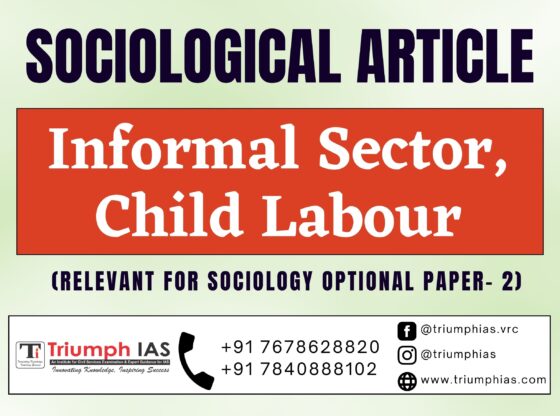Informal Sector, Child Labour
Relevant for sociology optional Paper- 2 (Unit- 13 : Social Changes in India)

In India, the informal sector is a critical source of employment, especially for those who are unable to find work in the formal sector. The informal sector refers to economic activities that are not regulated by the government and are outside the purview of labour laws. This sector includes street vendors, domestic workers, home-based workers, small-scale manufacturers, and other low-paying jobs. Unfortunately, the informal sector is also known for its extensive use of child labour.
Child labour is a widespread problem in India, affecting millions of children across the country. According to the International Labour Organization (ILO), there are approximately 10.1 million child labourers in India, accounting for 13.9% of the total workforce. This problem is especially prevalent in the informal sector, where children are often forced to work long hours for very little pay.
One of the primary reasons for the prevalence of child labour in the informal sector is the lack of regulation. Unlike the formal sector, which is subject to a variety of labour laws and regulations, the informal sector is largely unregulated. This means that employers in the informal sector are free to hire children and pay them significantly less than adult workers. Furthermore, many employers in the informal sector are unaware of the laws surrounding child labour or simply choose to ignore them.
Children who work in the informal sector are often from poor families who are unable to afford education for their children. These children are forced to work to supplement their family’s income, often starting at a very young age. In some cases, children are also trafficked into the informal sector and forced to work in factories or as domestic servants.
The use of child labour in the informal sector has numerous negative consequences. Children who work in the informal sector are often subjected to hazardous working conditions, including exposure to chemicals, heavy machinery, and dangerous tools. These working conditions can result in injuries or even death. Furthermore, children who work in the informal sector are often denied access to education, which can limit their future opportunities.
Efforts to address the problem of child labour in the informal sector have been hampered by a variety of factors. One of the biggest challenges is the lack of awareness among employers in the informal sector about the laws surrounding child labour. Many employers simply do not know that it is illegal to hire children, or they choose to ignore the laws.
Another challenge is the lack of resources available to enforce the laws surrounding child labour. The government has limited resources to monitor the informal sector, which makes it difficult to identify and prosecute employers who hire children. Furthermore, the penalties for violating child labour laws are often insufficient to deter employers from hiring children.
Despite these challenges, there have been some efforts to address the problem of child labour in the informal sector. The government has implemented a number of initiatives aimed at increasing awareness about child labour and enforcing the laws surrounding it. For example, the Ministry of Labour and Employment has launched the National Child Labour Project (NCLP), which aims to eliminate child labour in certain hazardous industries.
Non-governmental organizations (NGOs) have also played a critical role in addressing the problem of child labour in the informal sector. NGOs have worked to raise awareness about the issue and provide education and vocational training to children who have been rescued from child labour. They have also worked with the government to develop and implement policies aimed at eliminating child labour in the informal sector.
In conclusion, the informal sector in India is a critical source of employment, but it is also known for its extensive use of child labour. Children who work in the informal sector are often from poor families who are unable to afford education for their children. The lack of regulation and awareness surrounding child labour in the informal sector has led to the widespread use of child labour, which has numerous negative consequences. Efforts to address the problem of child labour in the informal sector must be intensified, and more resources must be devoted to enforcing the laws and regulations surrounding child labour. The government, NGOs, and other stakeholders must work together to raise awareness about the issue, provide education and vocational training to children, and develop policies aimed at eliminating child labour in the informal sector. Only through a concerted effort can we hope to eradicate the problem of child labour in the informal sector and provide a better future for the millions of children who are currently trapped in this cycle of poverty and exploitation.
For more such free UPSC notes, Articles, News & Views Join our Telegram Channel. https://t.me/triumphias
Click the link below to see the details about the UPSC – Civils courses offered by Triumph IAS. https://triumphias.com/pages-all-courses.php


